Unveiling the Magic of Modern Basement Makeovers
A successful basement makeover involves not just a well-thought-out design but also effective financial planning.
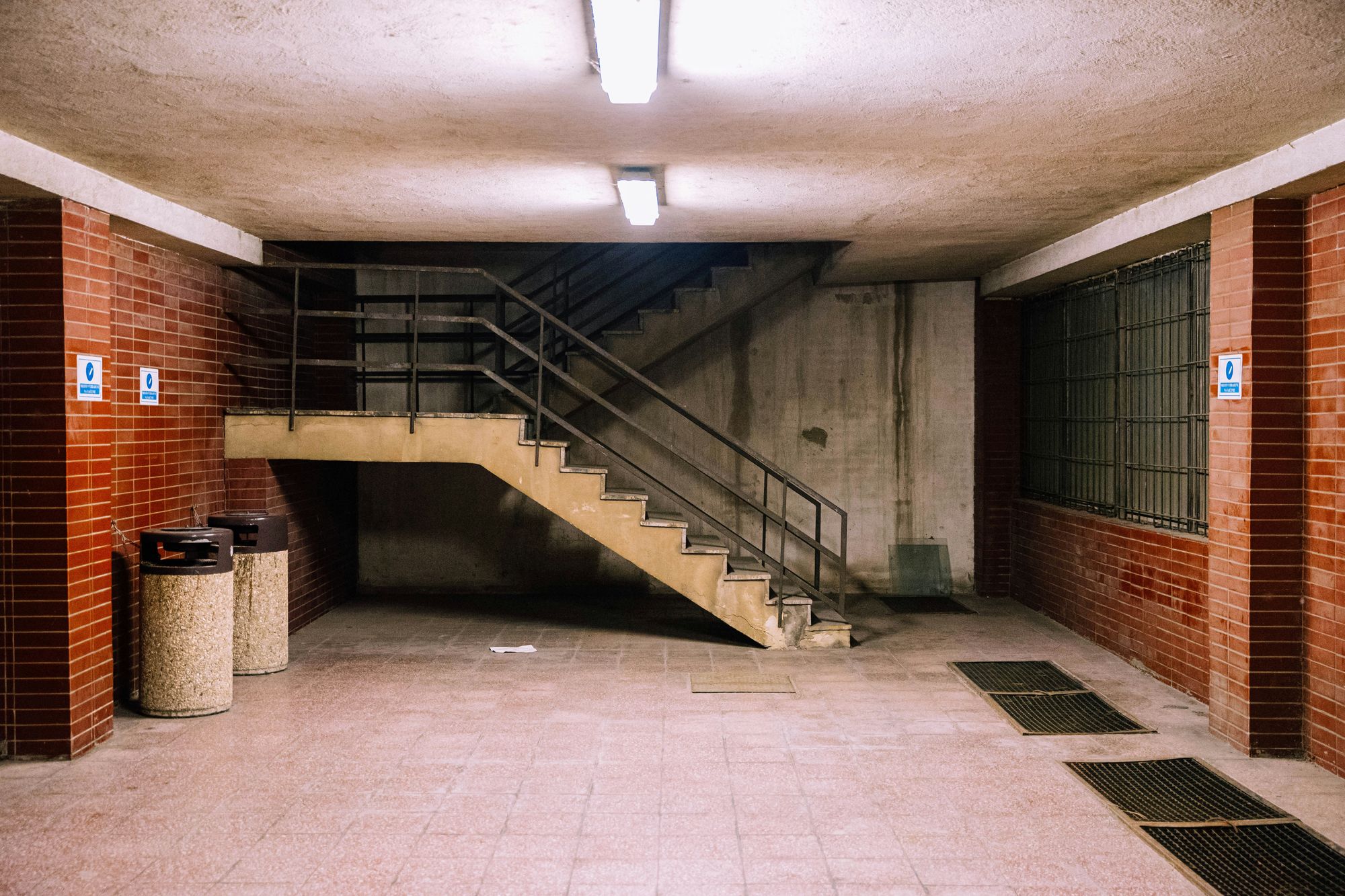
Table of Contents
- Introduction
- The Appeal of Modern Basement Makeovers
- Detailed Benefits Analysis of Basement Makeovers
- Introduction to Basement Redesign Idea
- Technological Advancements in Basement Redesign
- Real-Life Case Studies
- The Heart of Transformation
- Financing Your Basement Renovation: Practical Tips
- Conclusion
- FAQ: Answering Your Basement Makeover Questions
Key Takeaways
- Modern Basement Makeovers: A rising trend in home renovation, modern basement makeovers transform underutilized spaces into stylish, functional areas. Whether it's an additional living space, a home office, or a recreational area, basements offer immense potential.
- Considerations for Redesign: Each basement makeover should consider the basement's size, layout, and the homeowner's needs. Key modern interior elements to consider include lighting, flooring, wall treatments, and space utilization. Innovative design can help overcome common challenges like low ceilings or lack of natural light.
- Real-Life Case Study: A real-life example demonstrates the transformative power of a basement makeover. The case study highlights common challenges and their solutions, providing homeowners with practical insights for their renovation projects.
- Financing Tips: Basement renovations can be a significant investment. Homeowners should plan their budget carefully, considering factors like the cost of materials, labor, and unexpected expenses. Financing options such as home equity loans, personal loans, or savings should be explored.
- Unleashing Potential: Modern basement makeovers not only add aesthetic appeal but also increase a home's value. With careful planning, design considerations, and proper financing, homeowners can unleash the hidden potential of their basements, enhancing their living space and lifestyle.
Introduction: The Rising Trend of Modern Basement Makeovers
In recent years, a new trend has taken the home renovation industry by storm: modern basement makeovers. Once relegated to storage and seldom visited, basements are now being transformed into stylish, functional spaces that not only enhance the aesthetics of a home but also its value.
The appeal of basement renovations is multifold. Homeowners are appreciating the potential that lies beneath the surface, realizing that basements can be so much more than just a storage area. With thoughtful design and proper execution, these spaces can become home offices, playrooms, gyms, or even cozy family rooms - the possibilities are endless.
Modern basement makeovers are also a practical response to changes in lifestyle and work patterns. With more people working remotely and spending time at home, the need for additional functional space has become more significant than ever.
Moreover, these renovations are an investment, adding to the square footage and usability of a home, thereby increasing its market value.
This blog post will delve into the world of modern basement makeovers, exploring the benefits, considerations, and practical tips to transform your basement into a space that truly reflects your style and meets your needs.
The Appeal of Modern Basement Makeovers
The appeal of modern basement makeovers lies not just in the added functionality they provide, but also in the aesthetic enhancement they bring to the home. These modern transformations are increasingly making basements the heart of the home, where families gather to relax, work, play, and create memories.
One of the key advantages of a basement redesign is the flexibility it offers. With a generous space typically free from structural limitations like load-bearing walls, homeowners have a blank canvas that they can tailor to their unique needs and preferences. The basement can transform into anything from a sleek home office for remote work to a state-of-the-art home theater for family movie nights.
Modern interior elements play a crucial role in these makeovers, lending a contemporary and chic appeal to the space. Innovative lighting solutions can brighten up the typically dark basement, making it feel more spacious. Flooring options, from polished concrete to plush carpeting, can dramatically alter the look and feel of the room. Wall treatments like painted brick or wood paneling can add texture and depth, while modern furnishings and decor can infuse the homeowner's personal style.
Another significant appeal of modern basement makeovers is the potential increase in home value. A well-executed basement renovation not only adds to the livable square footage of the home but can also boost its market value.
Moreover, in the wake of the pandemic, homes with additional functional spaces like a renovated basement have become more attractive to potential buyers. This trend shows that investing in a basement redesign can have both immediate lifestyle benefits and long-term financial returns.
By considering these factors and using the right combination of modern interior elements, homeowners can successfully undertake a basement renovation, creating a space that is both stylish and functional, and that truly enhances their home.

Detailed Benefits Analysis of Basement Makeovers
Modern basement makeovers go beyond mere aesthetic enhancements, offering a multitude of benefits that significantly impact homeowners' lifestyle, functionality of the space, and even the financial value of the property.
Enhanced Lifestyle and Comfort: A well-designed basement renovation can transform a previously underused area into a vibrant living space tailored to specific family needs.
Whether it’s creating a cozy family room, an inspiring home office, or a private gym, these renovations allow for the customization of living spaces that cater to hobbies, work, or relaxation. For instance, a basement turned into a home theater can provide families with a dedicated space to enjoy movies, fostering quality time together.
Increased Property Value: Basement renovations are a smart investment in your property. By increasing the usable square footage of your home, they can significantly boost its market value. For example, adding a secondary suite in the basement can appeal to potential buyers looking for rental income opportunities, thereby increasing the property's attractiveness and resale value. On average, homeowners can expect a return on investment (ROI) of up to 70% on a well-executed basement renovation, making it a financially savvy project.
Improved Functionality and Space Utilization: Renovating your basement allows for better utilization of space, turning it into a functional area that meets your evolving needs. For families growing in numbers or individuals taking up new hobbies, the basement can be customized to serve as additional bedrooms, hobby rooms, or storage areas. Design choices such as built-in cabinets or modular furniture can enhance organization and reduce clutter, making the basement an integral part of the home’s overall functionality.
Energy Efficiency and Comfort: Modern basement renovations often include upgrades to insulation and HVAC systems, leading to improved energy efficiency. These changes can reduce heating and cooling costs throughout the year, making the basement - and the entire home - more comfortable. Additionally, incorporating energy-efficient lighting and appliances further contributes to a reduction in utility bills, aligning with sustainable living practices.
Introduction to Basement Redesign Ideas
Basements are often the most underutilized spaces in homes. However, with careful planning and creative ideas, they can be transformed into functional and visually appealing spaces. Below, we present six different basement redesign ideas along with a step-by-step guide and approximate cost estimates to help you embark on your renovation journey:
1. Home Office: In today’s remote working era, a basement home office offers a quiet, secluded space away from the household's hustle and bustle. Consider ergonomic furniture and ample storage to create a productive environment. Challenges might include ensuring adequate natural light; solutions can involve installing larger egress windows or using glass partitions to borrow light from adjacent spaces. Personalize the space with motivational art, a comfortable reading nook, or a coffee station for breaks.
- Plan the Layout: Define the space for your desk, chair, and storage units. Ensure there is enough room for free movement.
- Lighting Installation: Install appropriate lighting fixtures. Recessed lighting can cost between $150-$200 per fixture, inclusive of installation.
- Soundproofing: To maintain a peaceful work environment, consider soundproofing. This can cost approximately $1,000-$2,500 for a standard room.
2. Home Gym: A basement gym provides a convenient and private space for fitness enthusiasts. Key features might include rubber flooring for durability and shock absorption, mirrored walls to enhance natural light and aid in form correction, and a dedicated area for yoga or meditation. Challenges include ventilation and moisture control, which can be addressed with a proper HVAC system and dehumidifiers. Tailor the space to personal fitness goals with equipment that matches your workout preferences, from free weights to cardio machines.
- Space Allocation: Determine the space needed for your gym equipment, ensuring safe and easy movement.
- Flooring Installation: Opt for rubber flooring, which is ideal for a gym space. This can cost around $2-$3 per square foot.
- Mirror Installation: A wall mirror can cost around $500-$600.
3. Entertainment Area: Transform your basement into an entertainment hub with a home theater, games area, or bar. A projector and screen can create a cinema-like experience, while soundproofing ensures movies can be enjoyed without disturbing others. Challenges include creating a cozy atmosphere in a typically cool and dark basement, which can be overcome with strategic lighting, plush seating, and warm textiles. Personal touches might include themed décor for movie nights or a custom bar reflecting your taste in drinks.
- Seating and Screen Space: Plan for comfortable seating and a large screen.
- Soundproofing: Essential for a home theater to avoid disturbing other house members. The cost can be similar to a home office.
- Audio-Visual Equipment: Depending on the quality, the cost can start at $2,000.
4. Children’s Playroom: A basement playroom can offer a safe and creative space for children to play and learn. Incorporate bright colors, durable materials, and storage solutions for toys and art supplies. Potential challenges such as safety and lighting can be tackled with childproofing measures and vibrant, energy-efficient lighting. Make the space adaptable to grow with your children, featuring areas for reading, crafts, and active play. Personalization can come through with themed decorations or interactive elements like a chalkboard wall.
- Safety Measures: Childproof the room by installing safety gates and securing furniture. These measures can cost around $200-$400.
- Furniture and Storage: Install durable furniture and ample storage for toys. Expect to pay around $500-$1,000.
- Creative Elements: Add elements like a chalkboard wall or a reading nook to stimulate creativity. This can cost approximately $100-$200.
Remember, these are rough estimates, and actual costs can vary based on location, basement size, and the specific materials and products chosen. Always include a contingency in your budget for unforeseen expenses that may arise during the renovation.
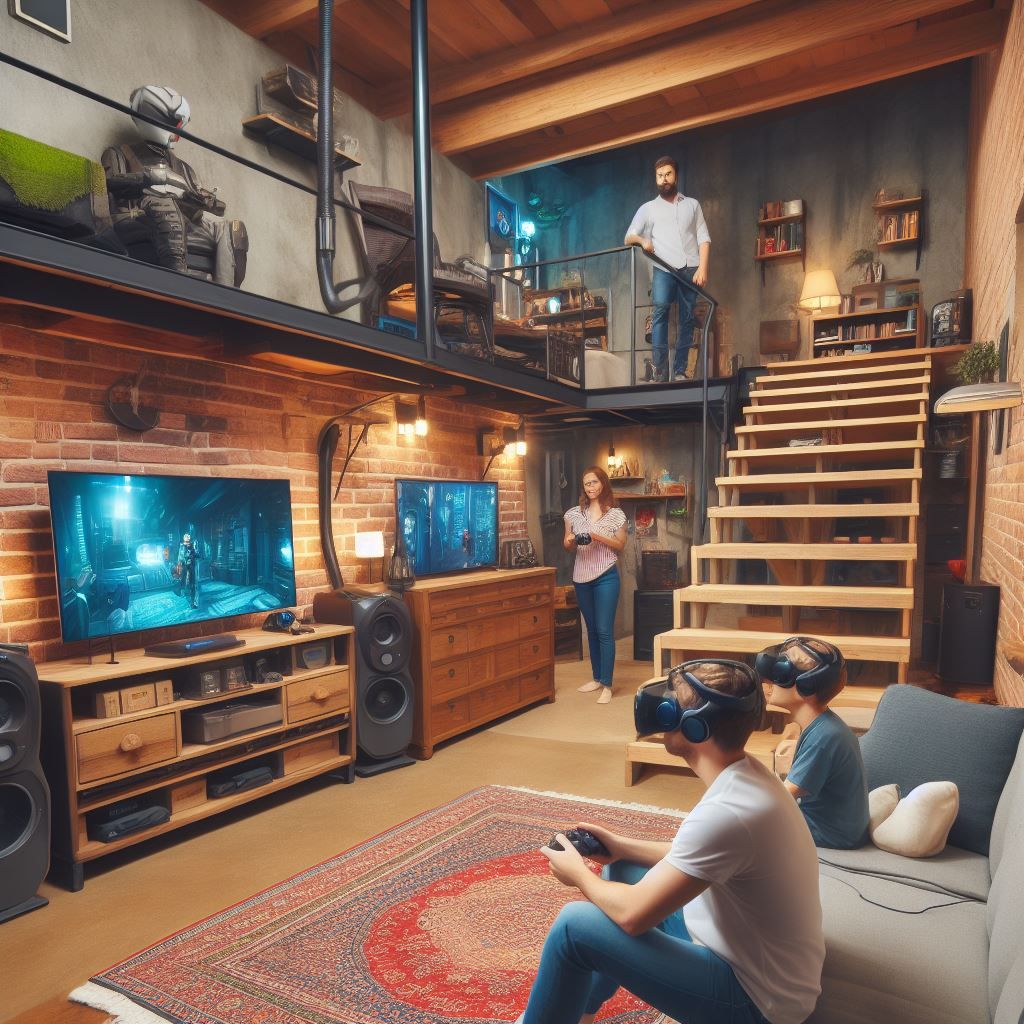
Technological Advancements in Basement Redesign
As technology continues to evolve and integrate into our daily lives, it has also begun to play a significant role in home renovations, particularly in basement redesigns. The advent of technological advancements has made it possible to transform basements into more functional, energy-efficient, and comfortable spaces. Let's explore the various roles technology plays in modern basement makeovers:
1. Smart Home Integration: Smart home technology has revolutionized the way we interact with our homes. From voice-controlled lighting and temperature regulation to remotely operated security systems, technology can make a redesigned basement more convenient and efficient. These features can be customized to personal preferences, ensuring a comfortable and personalized basement environment.
2. Energy Efficiency: Technological advancements have led to more energy-efficient solutions. LED lighting, for example, consumes less electricity and lasts longer than traditional lighting. Similarly, energy-efficient insulation materials can reduce heat loss and help maintain a comfortable temperature in the basement, reducing energy consumption and saving on utility bills.
3. Advanced Building Materials: Technology has also improved the building materials used in basement redesigns. Waterproof materials, mold-resistant drywall, and advanced flooring solutions not only ensure durability but also enhance the overall aesthetic appeal of the basement.
4. Virtual Reality (VR) and 3D Modeling: These technologies have revolutionized the planning and design stages of basement redesign. By creating a virtual model of the basement, homeowners can explore different design options, visualize the final look, and make necessary adjustments before the actual construction begins. This not only saves time and money but also ensures that the final result matches the homeowner's vision.
5. Sound and Entertainment Technology: Advancements in sound and entertainment technology have made it possible to create state-of-the-art home theaters or music studios in basements. High-definition screens, surround sound systems, and acoustic paneling can provide an immersive entertainment experience right in your home.
In conclusion, technology plays a pivotal role in modern basement redesigns, making them more efficient, comfortable, and tailored to the homeowner's needs. As technology continues to advance, we can expect even more innovative solutions for basement renovations in the future.
Modern Interior Elements to Consider: Element-by-Element Breakdown
Integrating modern interior design elements can transform a basement into a stylish, functional, and comfortable living space.
Lighting:
• Pros: Proper lighting can transform a dark, unwelcoming basement into a bright and inviting space. LED recessed lighting offers energy efficiency and long-lasting illumination, while pendant lights or track lighting can add style and focal points.
• Cons: Over-lighting can wash out a space, making it feel sterile. Dimmer switches can help, but initial installation costs may be higher.
• Best Use Cases: LED recessed lighting for general illumination, pendant lights over bars or seating areas, and task lighting in workspaces.
• Integration Tips: Combine various lighting types (ambient, task, accent) to create a layered effect. Use smart lighting systems for control and energy savings.
Flooring:
• Pros: Options like luxury vinyl plank or tile offer durability and moisture resistance, essential in basements. They can mimic the look of wood or stone for a fraction of the cost.
• Cons: Some flooring options may require subflooring installation to manage moisture, adding to the cost. Hard surfaces can also make basements feel colder.
• Best Use Cases: Luxury vinyl for a wood-look without the worry of water damage. Carpet tiles for areas needing warmth and sound insulation.
• Integration Tips: Use area rugs to add warmth and define spaces. Ensure any option chosen is suitable for below-grade installation.
Wall Treatments:
• Pros: Paint and wall panels can quickly update a space. Modern materials offer moisture and mold resistance, crucial for basement environments.
• Cons: Some wall treatments, like intricate paneling, can be expensive and may reduce room size slightly.
• Best Use Cases: Waterproof paint in light shades to brighten the space. Wood paneling or stone veneer for feature walls.
• Integration Tips: Choose light, neutral colors for paint to enhance the sense of space. Use paneling sparingly to avoid overwhelming the room.
Smart Home Features:
• Pros: Automated climate control, security, and entertainment systems increase comfort and functionality. Smart systems can also improve energy efficiency.
• Cons: The initial setup can be costly and require professional installation. Compatibility issues between devices may arise.
• Best Use Cases: Smart thermostats for efficient heating and cooling. Automated lighting and sound systems for entertainment areas.
• Integration Tips: Prioritize systems offering the most day-to-day convenience and energy savings. Ensure all smart devices are compatible with each other for seamless operation.
By focusing on minimalism, neutral colors, natural light, open spaces, innovative materials, technology integration, eco-friendly features and bold accents, you can create a basement that is truly at the heart of transformation.
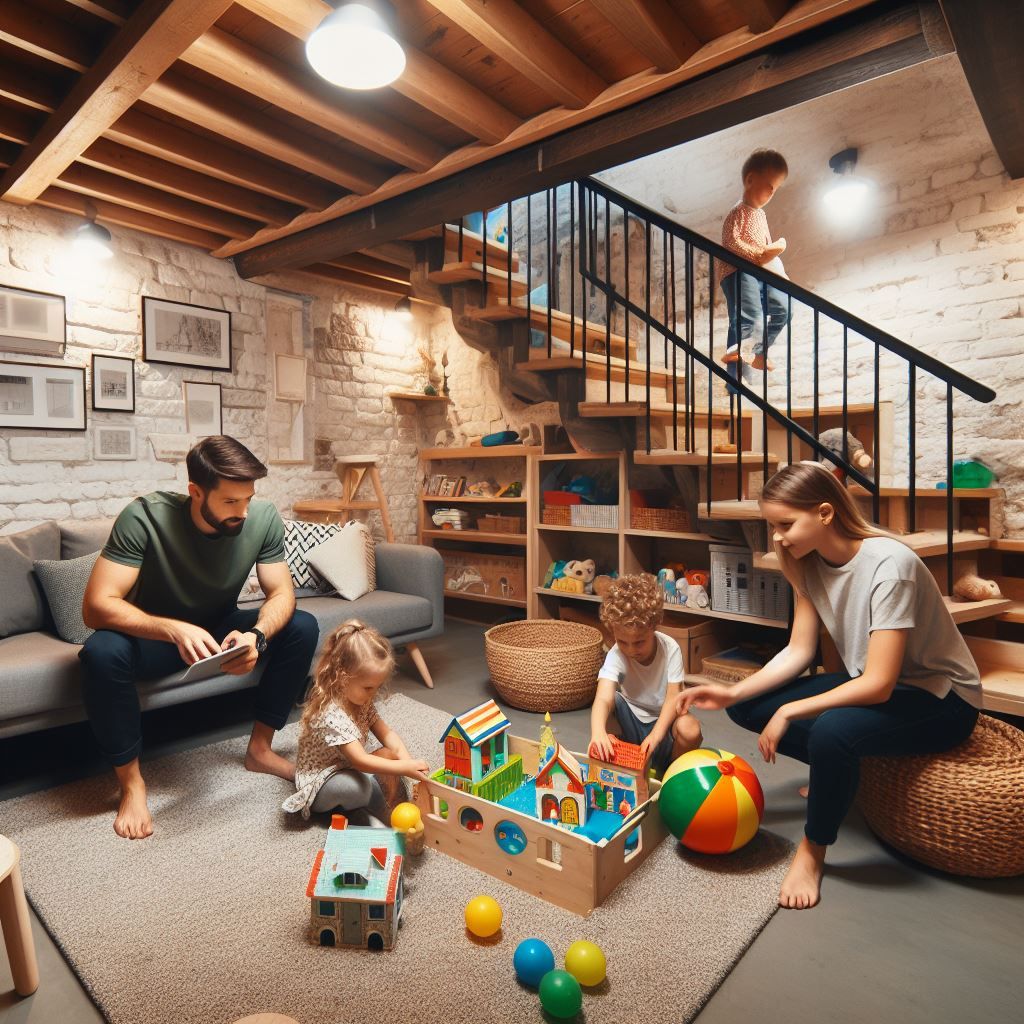
Real-life Case Studies
A basement redesign can transform an underused area into a functional and enjoyable space. This case studies explores a successful basement makeover, detailing the initial state of the basement, the redesign process, challenges faced, solutions implemented, and the final outcome.
Case Study 1:
Before:
The basement in question was a 1,000 square feet area, primarily used for storage. It was dark, damp, with a musty smell and minimal lighting. The homeowners wanted to convert it into a multipurpose space with an entertainment area, a small home gym, and a guest room. The budget for the project was set at $20,000, and the timeline was three months.
Process:
The first step involved clearing out the basement and assessing the space available. A professional contractor was hired to ensure the basement was structurally sound and to address any water leakage issues. Post inspection, an architect drafted a layout, dividing the space into three sections as per the homeowners' requirements.
Challenges and Solutions:
One of the main challenges encountered was dampness and a lack of natural light. The solution was to waterproof the basement and install energy-efficient LED lights for bright, cost-effective illumination. Another challenge was noise transmission between the basement and the main house. To solve this, soundproofing insulation was installed in the ceiling.
Outcomes:
The transformation was astounding. The previously damp and dark basement was now a vibrant, welcoming space. The entertainment area boasted a flat-screen TV and comfortable seating. The gym, equipped with basic workout equipment, and the guest room, complete with a bed and a small wardrobe, provided a cozy retreat for visitors. The soundproofing worked well, and the LED lights brightened the basement, making it feel more spacious.
Cost and Timeline:
The project was completed within the estimated timeline of three months. The breakdown of the $20,000 budget was as follows:
- Waterproofing and solving dampness issue: $5,000
- Installation of LED lights and electrical work: $3,000
- Soundproofing: $2,500
- Gym equipment: $2,000
- Entertainment setup: $4,000
- Furniture for the guest room: $2,500
- Labor and miscellaneous expenses: $1,000
The project was a success and stayed within budget. The homeowners were thrilled with their new, functional space, and the value of their property increased significantly due to this added usable space.
Case Study 2:
Before:
The basement in question was a 600 square feet space, cold, uninviting, and primarily used as a laundry area and storage. The homeowner desired to transform it into a cozy home office and a playroom for their children. The budget was set at $15,000 with a timeline of two months.
Process:
The process started with a thorough cleaning and inspection of the basement for any structural concerns. An interior designer was brought on board to create a layout dividing the basement into two functional areas. A contractor was responsible for executing the design and ensuring the space was safe and secure.
Challenges and Solutions:
The main challenges included poor lighting, cold temperature, and limited space. To address the lighting issue, recessed LED lights were installed. An energy-efficient heating system was introduced to tackle the cold temperature. To maximize the limited space, multifunctional furniture and storage solutions were incorporated.
Outcomes:
The transformation was remarkable. The once dull and cold basement was now a warm, bright, and inviting space. The home office was equipped with a desk, comfortable chair, and ample storage cabinets. The playroom was colorful, safe, and filled with creative elements like a chalkboard wall and a reading nook. The homeowner was pleased with the outcome, as the redesign not only fulfilled their needs but also significantly increased the overall property value.
Cost and Timeline:
The project was completed within the estimated timeline of two months. The $15,000 budget was allocated as follows:
- Lighting and electrical work: $2,000
- Heating system: $3,000
- Furniture and storage solutions: $4,000
- Children's playroom setup: $2,500
- Labor and other expenses: $3,500
Conclusion:
This case studies showcases how a basement can be repurposed into a functional and appealing space, regardless of its initial limitations. With thoughtful planning, creative design, and problem-solving, a basement redesign can not only meet the homeowner's needs but also add significant value to the property. This project emphasizes the importance of understanding the potential that lies beneath our homes, waiting to be unlocked.
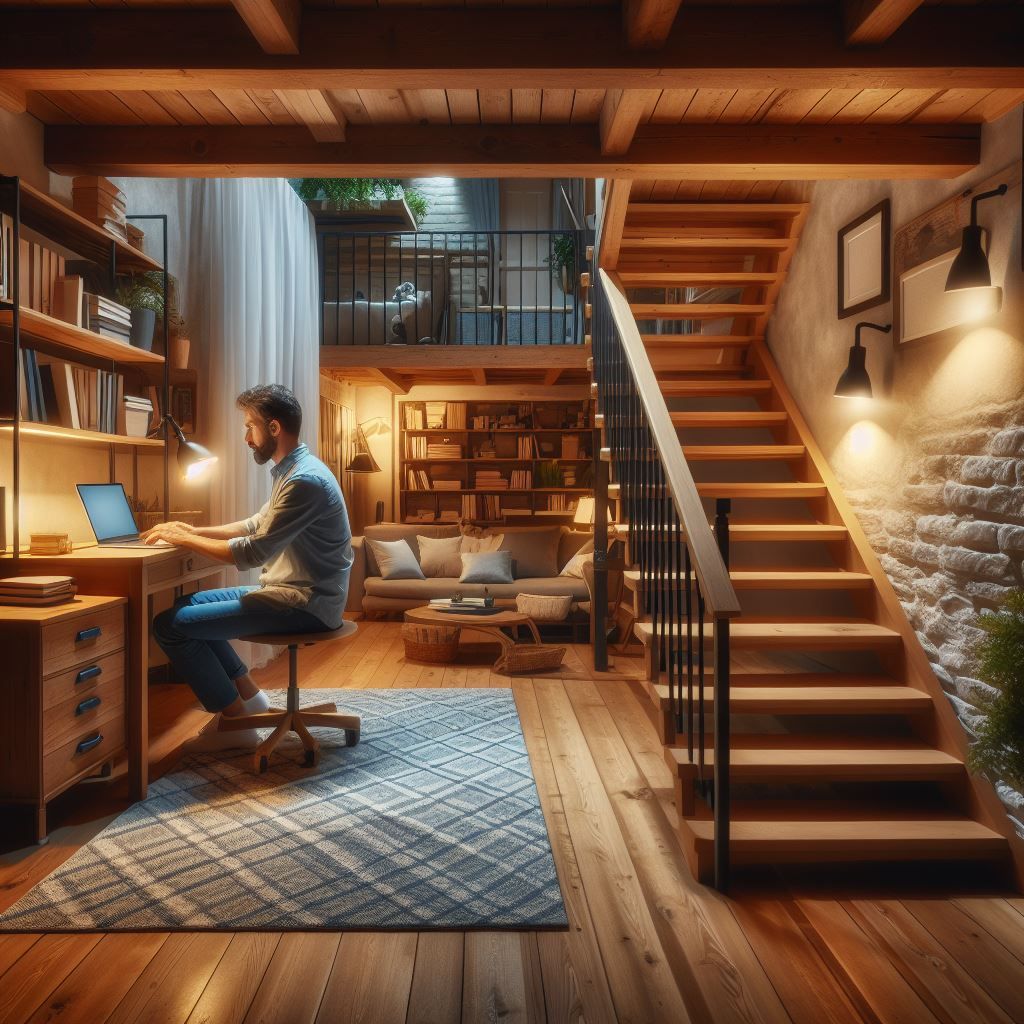
Financing Your Basement Renovation: Practical Tips
Renovating your basement can be a significant investment, but with careful planning and smart strategies, it is possible to manage the cost effectively. Here are some practical tips:
1. Set a Budget: Before starting, determine what you can afford to spend. The average cost of a basement remodel ranges from $10,000 to $27,000 but can go much higher depending on the scope of work. Once you have a budget, stick to it.
2. Get Multiple Quotes: Don't settle for the first contractor you find. Get quotes from at least three different contractors. Prices can vary by as much as 20%, so shopping around can save you thousands.
3. Prioritize: Decide what's most important to you in the renovation. If you're on a tight budget, focus on necessities like waterproofing and insulation, which can account for up to 25% of your budget, before moving to aesthetic improvements.
4. DIY Where Possible: You can save money by doing some tasks yourself. Simple jobs like painting or installing fixtures can cut labor costs, which typically make up about 20% to 35% of the total project cost.
5. Finance Smartly: If you don't have the cash on hand, consider financing options. Home equity loans or lines of credit may offer lower interest rates than personal loans or credit cards. Alternatively, some contractors offer financing plans.
6. Plan for Unexpected Costs: In renovation, surprises are almost a given. Set aside an additional 10% to 20% of your budget for unforeseen expenses.
7. Reuse and Recycle: If possible, reuse existing materials. For example, if your basement has old hardwood that's in good condition, consider refinishing it instead of buying new flooring.
8. Time Your Renovation: Some seasons are more expensive for renovations than others. Winter tends to be slower for contractors, so you might be able to negotiate a better rate.
9. Energy Efficiency: Consider energy-efficient options, like LED lights or high-efficiency HVAC systems. They might cost more upfront, but they'll save you money on utility bills in the long run.
10. Avoid Over-improvement: Don't overdo it. A basement remodel should increase your home's value, but the return on investment typically caps at around 70%. Spend wisely to ensure you're not putting in more money than you'll get back when you sell.
Remember, a basement renovation is an investment in your home. By setting a budget, shopping around, prioritizing, doing some work yourself, financing wisely, planning for unexpected costs, reusing materials, timing your renovation, thinking about energy efficiency, and avoiding over-improvement, you can manage the cost effectively.
Financing Your Basement Renovation: Detailed Financing Advice
Financing a basement renovation requires careful consideration of the options available, balancing the need for manageable payments with the overall cost of the project.
Savings:
• Pros: Using savings means no interest payments, keeping the total cost down. It also avoids potential debt.
• Cons: It can deplete emergency or other savings, leaving less buffer for financial surprises.
• Tips: Only use savings if you can maintain an emergency fund. Consider splitting costs between savings and financing to keep some reserves.
Home Equity Loans and HELOCs:
• Pros: Typically offer lower interest rates than personal loans or credit cards. Interest may be tax-deductible.
• Cons: Your home is used as collateral, risking foreclosure if payments are missed. HELOCs have variable rates, which can increase over time.
• Tips: Compare offers from multiple lenders to find the best rates and terms. Consider a fixed-rate home equity loan for predictable monthly payments.
Personal Loans:
• Pros: No collateral required. Fixed interest rates provide predictable payments. Quick funding times.
• Cons: Higher interest rates compared to home equity options. Shorter repayment terms can lead to higher monthly payments.
• Tips: Shop around for the best rates and terms. Good credit can secure lower interest rates, so consider improving your credit score before applying.
Credit Cards:
• Pros: Convenient for smaller purchases or short-term financing. Potential rewards or cash back.
• Cons: High-interest rates can significantly increase the total cost if the balance isn't paid off quickly.
• Tips: Use credit cards strategically for purchases you can pay off within the billing cycle. Look for cards with 0% APR introductory offers for larger, short-term expenses.
Government Loans and Grants:
• Pros: Some programs offer low-interest loans or grants for specific projects, especially those improving energy efficiency.
• Cons: Funds are often limited to specific improvements and may have strict eligibility requirements.
• Tips: Research local, state, and federal programs early in the planning process. Energy-efficient upgrades not only offer potential financing benefits but also long-term utility savings.
By exploring various financing routes and understanding their nuances, homeowners can make informed decisions that align with their financial situations and renovation goals.
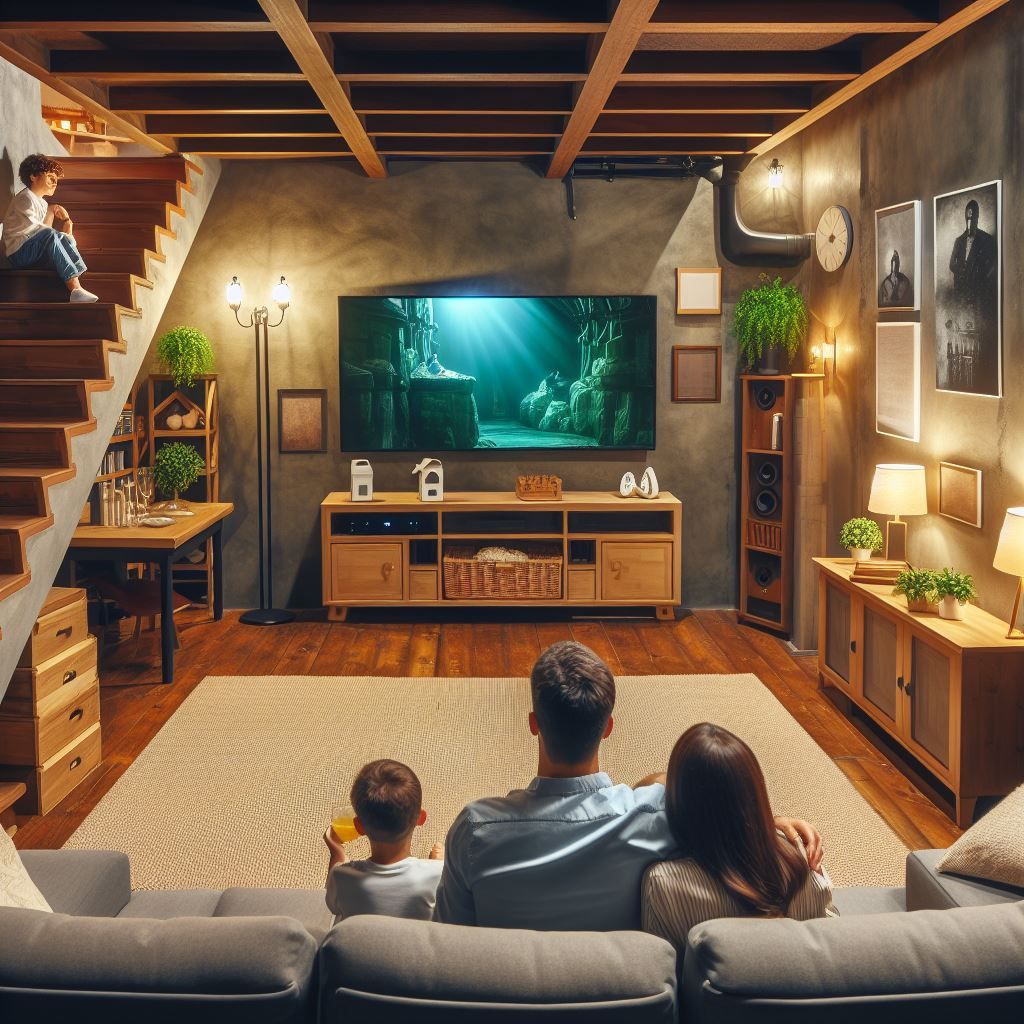
Conclusion: Unleashing the Potential of Your Basement
Basements, often the most overlooked areas of our homes, hold immense potential. By understanding the value of this underutilized space and investing in its transformation, homeowners can drastically enhance their living environment and increase their property's value.
Primarily, modern interior elements like minimalism, neutral color palettes, natural light, open floor plans, innovative materials, technology integration, eco-friendly features, and bold accents can redefine the aesthetics of a basement. These elements don't merely transform the space into a visually appealing area; they also ensure functionality and comfort.
A successful basement makeover involves not just a well-thought-out design but also effective financial planning. Setting a realistic budget, getting multiple quotes, prioritizing tasks, doing DIY where possible, smartly financing the renovation, planning for unexpected costs, reusing and recycling materials, timing the renovation wisely, and avoiding over-improvement are practical strategies to manage the renovation cost effectively.
Additionally, the integration of modern technology and eco-friendly elements in the design not only aligns with contemporary trends but also contributes to long-term savings, making the renovation a sustainable investment.
However, it's essential to remember that every basement renovation should be tailored to the homeowner's specific needs and preferences. Whether the aim is to create a cozy home office, a vibrant playroom, or a relaxing entertainment area, the ultimate goal should be to maximize the functionality of the space while reflecting personal style and taste.
In conclusion, a well-planned and executed basement renovation can unlock invaluable square footage in your home, providing new opportunities for function and design. As we continue to spend more time in our homes, these transformations offer an excellent opportunity to enhance our living spaces, making them more enjoyable and beneficial than ever before. Truly, the potential of your basement is waiting to be unleashed.
FAQ: Answering Your Basement Makeover Questions
1. How much will a basement renovation cost?
The cost varies widely depending on the scope of your project. On average, a basement remodel can range from $10,000 to $27,000. Prioritizing tasks and smart financial planning can help manage costs effectively.
2. What modern interior elements should I consider for my basement?
Consider elements such as minimalism, neutral color palettes, natural lighting, open floor plans, innovative materials, technology integration, eco-friendly features, and bold accents. These aspects can transform your basement into a modern, functional space.
3. Can I do some of the renovation work myself?
Yes, DIY tasks like painting or installing fixtures can cut down on labor costs, which typically make up 20% to 35% of the total project cost.
4. How can I bring natural light into my basement?
Consider installing egress windows or light wells if possible. For artificial lighting, LED lights can mimic daylight and create a warm ambiance.
5. Is a basement renovation a good investment?
Absolutely. While the return on investment caps at around 70%, a well-executed basement renovation can increase your home's value and enhance your living environment.
